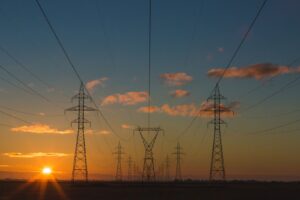Climate change is undeniably one of the most pressing challenges of our time, with far-reaching consequences for ecosystems, societies, and economies. Often discussions about climate change conjure images of melting ice caps, rising sea levels, and the difficulty of polar bears. However, there exists a crucial yet less-discussed facet of climate change – its profound influence on critical infrastructure resilience.
As global temperatures rise and extreme weather events become more frequent and intense, critical infrastructure systems are facing unprecedented challenges that threaten their ability to function effectively. This upheaval jeopardizes the very fabric of our world. Given our heightened dependence on these infrastructures for the smooth functioning of society, the symbiotic relationship between critical infrastructure and our way of life is now more intertwined than ever before.
The question then arises: How can we shield our future and safeguard our planet from the rising threat of climate change?
In this article, we will explore how climate change disrupts critical infrastructure resilience, the implications this has for our societies, and how we can combat this vital issue. Let’s dive in.
The Relationship Between Climate Change and Critical Infrastructure Resilience

Critical infrastructure refers to the vital systems and assets that are essential for the functioning of societies and economies, including energy, water supply, transportation, telecommunications, and healthcare. These systems provide the backbone for modern life, enabling everything from powering homes and businesses to the movement of goods and services.
However, as the climate continues to change, critical infrastructure is increasingly vulnerable to a range of impacts:
- Extreme Weather Events: Rising temperatures and changing weather patterns contribute to more frequent and severe weather events, such as hurricanes, floods, wildfires, and heat waves. These events can damage infrastructure directly or disrupt the supply chains that keep them operational.
- Sea-Level Rise: Coastal infrastructure faces significant risks due to sea-level rise, which can lead to increased flooding, erosion, and saltwater intrusion. This affects not only coastal cities but also ports, power plants, and other vital facilities located near the coastline.
- Changing Precipitation Patterns: Altered precipitation patterns can lead to droughts in some regions and heavy rainfall in others. Both scenarios can strain water supply systems, affecting agriculture, drinking water availability, and hydropower generation.
- Ecosystem Disruption: Climate change can disrupt ecosystems that support critical infrastructure, such as forests that help regulate water flow and reduce erosion. Loss of these natural services can exacerbate infrastructure vulnerabilities.
- Heat Stress: Increasing temperatures can lead to overheating of infrastructure components, such as electrical systems, and strain cooling systems, affecting energy and manufacturing facilities.
Implications for Critical Infrastructure Resilience

Critical infrastructure Resilience is the ability to prepare for, respond to, and recover from disruptive events. Climate change introduces new and complex challenges to achieving resilience:
Increased Costs: The need to adapt infrastructure to changing climate conditions and repair damage from extreme events can significantly increase costs. Governments and private entities must allocate resources to address these challenges, potentially diverting funds from other essential services.
Interconnectedness: Critical infrastructure systems are interconnected and interdependent. A failure in one system, such as a power outage due to a storm, can set off disruptions in other sectors like healthcare and transportation. This intricate web of relationships mirrors the domino effect, where the fall of one piece sets off a cascade that brings down the entire sequence.
Long-Term Planning: Traditional infrastructure design and planning may no longer be sufficient. Long-term climate projections must be integrated into infrastructure planning to ensure that systems remain operational throughout their intended lifespans.
Social and Economic Disruptions: Infrastructure failures can lead to disruptions in daily life, economic losses, and social upheaval. Vulnerable communities are often disproportionately affected, amplifying existing inequalities.
Policy and Regulation: Governments and regulatory bodies must adapt policies to incorporate climate resilience requirements into infrastructure development and maintenance standards.
Building Climate-Resilient Infrastructure

Addressing the disruptive impacts of climate change on critical infrastructure requires a comprehensive and multi-faceted approach:
Investment in Resilience: Governments and industries must invest in upgrading and retrofitting existing infrastructure to withstand climate-related stressors. This may involve elevating structures, strengthening foundations, and enhancing drainage systems.
Innovative Design: Incorporating climate projections into the design of new infrastructure projects can ensure they are equipped to handle future conditions. Green infrastructure solutions, such as permeable pavements and green roofs, can help manage stormwater and reduce heat stress.
Diversification of Resources: Reducing dependence on single sources of energy, water, and other critical resources can enhance resilience. Transitioning to renewable energy sources and implementing water-efficient technologies are examples of such diversification.
Early Warning Systems: Developing robust early warning systems can help mitigate the impacts of extreme events by allowing for timely evacuation and preparedness measures.
Community Engagement: Engaging local communities in the planning and decision-making processes for critical infrastructure projects can lead to solutions that are better suited to the unique needs and vulnerabilities of each area.
Resilience Training Workshops: Participating in regular resilience-enhancing workshops, such as EARTHEX, reveals potential vulnerabilities within infrastructure, facilitates cross-sector issue resolution, nurtures collaborative problem-solving, shapes strategic recovery frameworks, and ensures uninterrupted continuity for years to come.
A Resilient Future

Climate change is a complex and multifaceted challenge that extends far beyond rising temperatures and melting ice caps. Its impact on critical infrastructure resilience is a crucial aspect that deserves our attention and action. By recognizing the vulnerabilities posed by climate change and taking proactive steps to build climate-resilient infrastructure, we can ensure that societies continue to thrive even in the face of an uncertain climate future.
The time to act is now, as the resilience of our critical infrastructure is central to the well-being and prosperity of our global community.
Want to help in this important endeavor? Join us! Members of the EIS Council enjoy unlimited access to a wealth of resources developed by global leaders and industry experts, resilience training exercises, a global community of like-minded individuals, and countless events bringing together experts to brainstorm and tackle these crucial issues. By becoming a part of our community, you can contribute to the collective effort to enhance critical infrastructure resilience in the face of climate change.
Together, we can drive innovation, advocate for policy changes, and work towards creating a more sustainable and resilient future for generations to come.
Create Impact with us:
Join our membership and
contribution programs
Participate in our
upcoming events:
Schedule a call with
our experts:
Advancing Earthquake Resilience: Strategic Urban Planning and Global Partnerships
In an era where urban landscapes continue to sprawl and the frequency of natural disasters seems to be on the rise, the importance of building resilient cities has never been more pronounced. Earthquakes, in particular, pose a significant risk to densely populated areas, with the power to cause extensive damage and incur millions in damage […]
Cyber Resilience in the Energy Sector: Safeguarding the Grid from Digital Disruptions
In today’s interconnected world, the energy sector stands as a vital backbone of national and global infrastructures, facilitating everything from lighting our homes to powering industries. However, this sector is increasingly finding itself in the crosshairs of cybercriminals, making cyber resilience not just a matter of technological integrity but of national security. The concept of […]
The Role of Local Governments in Strengthening Infrastructure Resilience
The significance of local governments in strengthening infrastructure resilience cannot be understated. Often perceived as entities primarily focused on addressing routine community concerns and improvements, their responsibilities extend far beyond these day-to-day operations. In the realm of preparing for and mitigating the effects of large-scale, catastrophic events—referred to as “black sky” disasters—local governments emerge as […]


